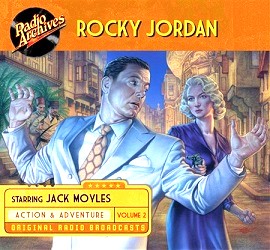
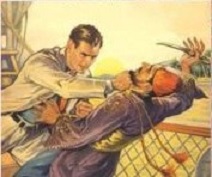 “Cairo, gateway to the Ancient East…where modern adventure and intrigue unfold against the backdrop of antiquity…”
“Cairo, gateway to the Ancient East…where modern adventure and intrigue unfold against the backdrop of antiquity…”
Rocky Jordan (1948-1950) aired “The Secret of Wong Lee” on March 5, 1950. This is the 15th Rocky Jordan episode we have showcased since 2011 and the first in almost a year. From a previous introduction and for the benefit of new listeners unfamiliar with the Rocky Jordan program, here are the basics of the show’s background. Rocky Jordan ran from October 21, 1948 through September 5, 1950 and starred Jack Moyles as Rocky Jordan. There were several iterations of the show, the first of which aired in 1945 under the title A Man Named Jordan. Only two episodes of this early precursor are known to still exist. This version was set in Istanbul, Turkey but was otherwise the same as its successor. An attempt to revive the series with famed Hollywood actor George Raft aired for one season from 1950-51. A couple of half-hearted attempts were made at further revivals in 1955 and ’57, but none of these fifteen-minute episodes survive.
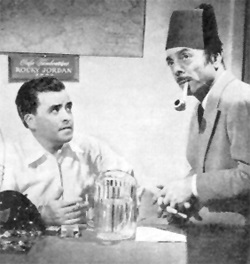 Rocky Jordan was modeled on the classic, much revered movie Casablanca, which premiered in New York on November 26, 1942 and then in general release on January 23, 1943. Casablanca starred Humphrey Bogart as Rick Blaine, the American exile who ran Rick’s Cafe Americain in Casablanca, Morocco, an unallied country during World War II located in northwest Africa and bordering the Mediterranean Sea. Rocky Jordan is set in Cairo, Egypt, in northeast Africa, said country also bordering the Mediterranean. Rocky calls St. Louis home (but was chased abroad by his enemies), whereas Rick hailed from New York; both are intimated to have shady pasts. The counterpart to Rick’s Cafe Americain is Rocky Jordan’s Cafe Tambourine, not far from the “mosque Sultan Hassan,” (photo below) where Rocky finds himself routinely involved with “crime, mystery, and beautiful women.” Much like Rick’s Cafe Americain which is set during WW II, Jordan’s Cafe Tambourine, while set a few short years following the war, is a magnet for all ethnicities and types, from the respectable to the rogue.
Rocky Jordan was modeled on the classic, much revered movie Casablanca, which premiered in New York on November 26, 1942 and then in general release on January 23, 1943. Casablanca starred Humphrey Bogart as Rick Blaine, the American exile who ran Rick’s Cafe Americain in Casablanca, Morocco, an unallied country during World War II located in northwest Africa and bordering the Mediterranean Sea. Rocky Jordan is set in Cairo, Egypt, in northeast Africa, said country also bordering the Mediterranean. Rocky calls St. Louis home (but was chased abroad by his enemies), whereas Rick hailed from New York; both are intimated to have shady pasts. The counterpart to Rick’s Cafe Americain is Rocky Jordan’s Cafe Tambourine, not far from the “mosque Sultan Hassan,” (photo below) where Rocky finds himself routinely involved with “crime, mystery, and beautiful women.” Much like Rick’s Cafe Americain which is set during WW II, Jordan’s Cafe Tambourine, while set a few short years following the war, is a magnet for all ethnicities and types, from the respectable to the rogue.
 As you might imagine, Rocky seems always to find himself at the center of trouble. Egyptian-Muslim police Captain Sam Sabaaya (married with four children) plays it straight and by the book but helps Rocky when he can, while Sabaaya’s Sergeant Greco dislikes Jordan and attempts to pin every mishap and crime on the part-time detective and foreigner.
As you might imagine, Rocky seems always to find himself at the center of trouble. Egyptian-Muslim police Captain Sam Sabaaya (married with four children) plays it straight and by the book but helps Rocky when he can, while Sabaaya’s Sergeant Greco dislikes Jordan and attempts to pin every mishap and crime on the part-time detective and foreigner.
The writers always strove for authenticity in Rocky’s adventures, researching names of streets and places for accuracy, and the show’s producers even hired an Egyptian writer/consultant in later episodes for further accuracy of detail in regard to the locales and various cultures, Cairo being a centuries-long crossroads and melting pot of the Middle East.
“The Secret of Wong Lee,” quite coincidentally, deals with the theme of immigration as did our Green Hornet story from two weeks ago, “Income from Immigrants,” although the particulars are of course different. In this story, a well respected doctor living in the Chinese quarter of Cairo, the titular Wong Lee, has asked that Rocky and one other come to his home on a most urgent matter. When all are assembled, Wong Lee matter-of-factly shoots and kills the third man in front of Rocky, and tells Rocky he is to tell the police what he has just seen. This begins a series of seemingly unconnected events, including the history of a group of Chinese people immigrating and assimilating into the Egyptian life of Cairo some fifteen years before, how Wong Lee’s son is involved as a member of the United States’ Intelligence Office on duty in the region, and what eventually is learned about the true “Secret of Wong Lee.” A well written and produced episode and worth a listen.
(The CD linked above includes this episode and 19 others, all digitally remastered.)
Play Time: 29:43
{This episode of Rocky Jordan aired on a Sunday evening in early March of 1950. As such, the neighborhood gang had only to wait for the end of school the next day before heading to the nearby newsstand in hope that anything new had arrived since their last visit. Fantastic Adventures Quarterly (1941-43, 1948-51) was an odd duck of sorts. Each issue contained three unsold past issues bundled into one giant issue that ran between 400 and 500 pages. Though the gang’s various collections were as complete as possible, there was always the distinct possibility that a few issues of their favorite pulps had escaped their notice over the years, so a multi-issue package featuring all the stories from three past issues was not to be passed by. Private Detective (1937-50) was an interesting blend of hardcore detective fare and comics of all things. Through its inception in 1937 this detective pulp was characterized as being a less socially offensive version of its elder sister magazine Spicy Detective, but with somewhat less lurid covers and a notch down when it came to the sociopathology of its villains. It was a solid monthly through 1945, after which its schedule became quite hit and miss. In 1949 it added the comic strip feature, but if this gimmick worked at all it was too little and too late, with the magazine folding six issues after the one depicted below and ending its run with 9 issues in 1950. Super Science Stories (1940-43, 1949-51), despite attracting top talent for many of its issues during both of its short iterations, managed only a total of 31 irregularly published issues. A few of its heavy hitter raconteurs were Ray Bradbury, Henry Kuttner, A. E. van Vogt, L. Sprague de Camp, Manly Wade Wellman, Murray Leinster, Fredric Brown, L. Ron Hubbard, George O. Smith, and Poul Anderson. It was a bi-monthly in 1950.}
[Left: fantastic Adventures Qtly., Spring/50 – Center: Private Detective, 3/50 – Right: Super Science Stories, 3/50]
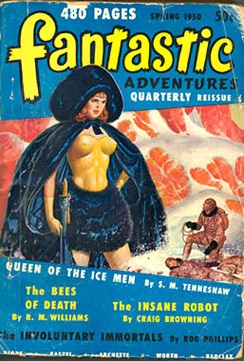
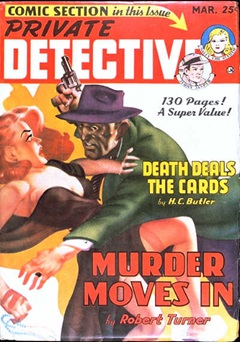
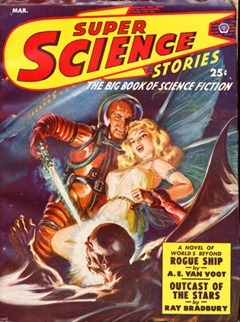
To view the entire list of weekly Old Time Radio episodes at Tangent Online, click here.